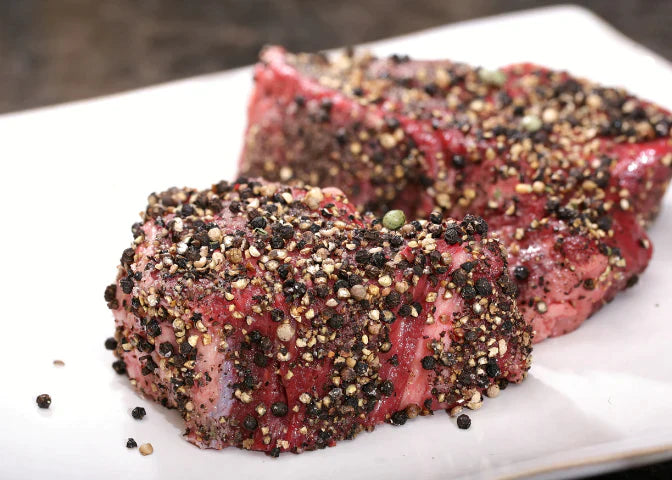Brining meat is as simple as sprinkling salt on it or submerging it in a saline solution and letting the salt work its way into the meat through various natural scientific processes. Brining is more beneficial to some cuts of meat than others. Because they don’t have as much fat to offer moisture and taste, drier, leaner meats are at the top of the list of cuts that could benefit from a good ole brine. Brining is a fantastic option for poultry breasts, pork chops, shrimp, and the famous Thanksgiving turkey.
How It Works
Essentially, brining has two modes of action. The salt changes the protein structures in the meat. It causes the cells to hold on to more moisture, thereby trapping water inside. Some of the moisture disappears when the meat is cooked, but the majority stays. Secondly, the brine also softens the tough muscle fibers in the meat, preventing them from stiffening up while cooking. Because the loose fibers are less prone to squeak out water, the smoked meat remains moist.
In other words, moisture is absorbed into the meat fibers and trapped there while brining. As moisture loss is unavoidable throughout the cooking process, brining enhances the trapping of the moisture inside a piece of meat. While it loses less moisture while cooking, your meat comes out more moist and juicier than it would otherwise.
Types of Brine
Wet and dry brining are the only two ways to brine your meat.
Wet Brining
One cup of kosher salt to each gallon of water is the basic ratio for any wet brine. Make sure the salt is completely dissolved in the water. Add some smashed garlic cloves, peppercorns, citrus (also smashed), or even a sweetener like honey or brown sugar if you’re feeling fancy. You can also use apple juice instead of water to give the poultry a delicious fall flavor. If your meat has skin on it (hello, turkey), drain it, pat it dry, and place it in the fridge, uncovered, a few hours before cooking. It’ll be juicy and soft, with a shatteringly crisp skin that turns a gorgeous golden brown as the meat cooks.

Dry Brining
Dry brining is more correctly described as a rub, or a “cure,” for your meat, as the phrase “brining” implies a liquid. The end product, though, is very similar. It re-distributes moisture and pulls flavor deep into the meat by covering it with a salty dry brine. Dry brining is also a clean, easy seasoning option if you don’t want to clutter your fridge with enormous containers of immersed meat for whatever reason; as an example, assume you’re my in-laws, who once spilled gallons of wet brine all over their newly rebuilt kitchen on Thanksgiving morning, just an hour before visitors began to arrive.
Dry brining requires one teaspoon of kosher salt per pound of meat, plus whatever other ingredients like herbs and seasonings you want. It’s critical to use kosher salt instead of table salt because it’s substantially less salty. With a mortar and pestle, mash everything into a sandy texture, then rub it into your meaty canvas. Dry brining a chunk of beef takes a little longer than wet brining.
How Long Does It Take to Brine Meat?
Generally, it’s acceptable to brine your meat for at least an hour per pound, after which it will be ready for smoking.
However, it’s good to note that it will become overly salty if you keep beef in the brine solution for long. It’s sometimes possible to reverse the action by soaking the meat in cold water to neutralize the extra salt, but it’s not always successful. You can produce excess protein denaturation and render the meat mushy if you brine it for too long, and there’s no way to remedy it.
Brining super-thin meat cuts such as fish filets for 10 minutes is a practical rule of thumb. Other meats, such as shrimp and thin pork chicken breasts or chops, normally require 15 to 30 minutes to brine. Larger meats, such as a whole chicken, can be brined overnight, and huge turkeys can be brined for up to 48 hours.

Quick Tips to Brine Like a Pro
- A pinch or two of sugar added to your dry brine can aid in the caramelization of the meat while it cooks.
- Brining in the fridge is important to protect the meat from bacterial contamination.
- Avoid exposing the meat to the air as it can be contaminated with food-borne bacteria.
- Patting your turkey down with dry paper towels is essential for the bird to remain crispy as it absorbs the excess moisture from the meat.
- Allow your meat to come to optimal or room temperature from the fridge before transferring it into the smoker.
You now have the best tips for brining your favorite meat for a savory and delicious meal. Check our Bradley Smoker blog for more tips and tricks.
Check out our entire catalog of articles on brining and curing your meat here:
What’s the Difference Between Pickling, Brining, Marinating, and Curing?
Curing and Smoking Meats for Home Food Preservation
Directions On Brining And Curing Your Meat For Food Smoking





